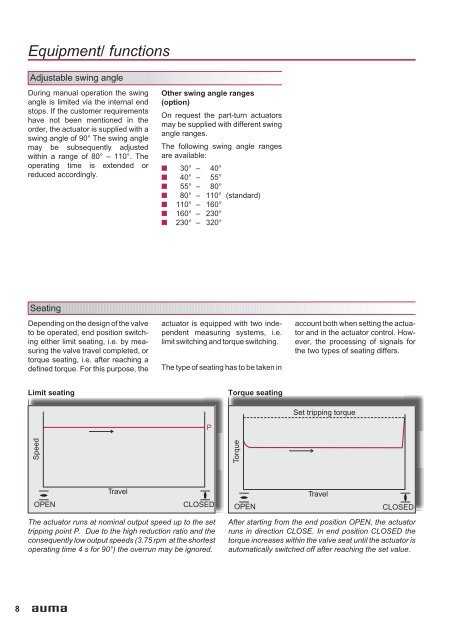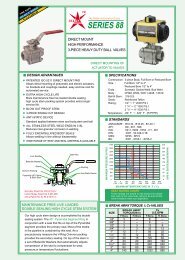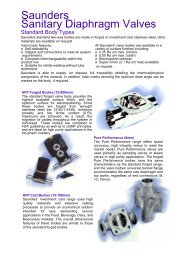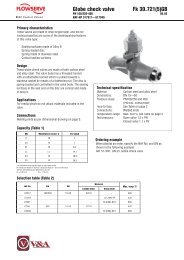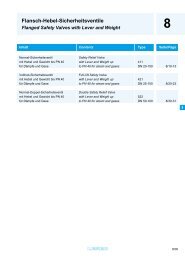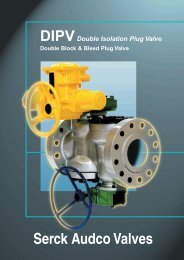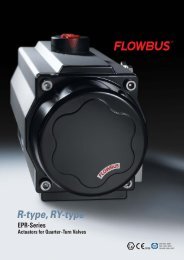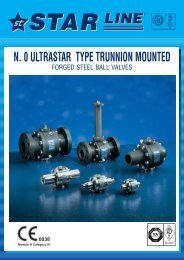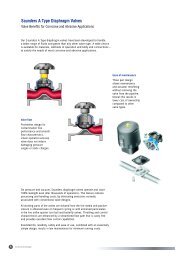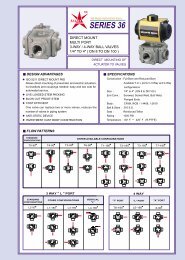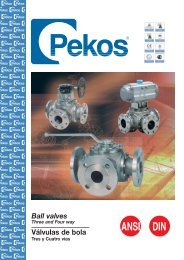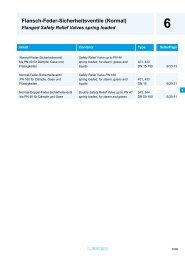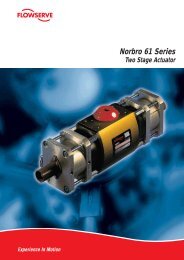Equipment/ functions - Process Valve Solutions
Equipment/ functions - Process Valve Solutions
Equipment/ functions - Process Valve Solutions
You also want an ePaper? Increase the reach of your titles
YUMPU automatically turns print PDFs into web optimized ePapers that Google loves.
8<br />
<strong>Equipment</strong>/ <strong>functions</strong><br />
Adjustable swing angle<br />
During manual operation the swing<br />
angle is limited via the internal end<br />
stops. If the customer requirements<br />
have not been mentioned in the<br />
order, the actuator is supplied with a<br />
swing angle of 90° The swing angle<br />
may be subsequently adjusted<br />
within a range of 80° – 110°. The<br />
operating time is extended or<br />
reduced accordingly.<br />
Seating<br />
Depending on the design of the valve<br />
to be operated, end position switching<br />
either limit seating, i.e. by measuring<br />
the valve travel completed, or<br />
torque seating, i.e. after reaching a<br />
defined torque. For this purpose, the<br />
Limit seating<br />
Speed<br />
Other swing angle ranges<br />
(option)<br />
On request the part-turn actuators<br />
may be supplied with different swing<br />
angle ranges.<br />
The following swing angle ranges<br />
are available:<br />
■ 30° – 40°<br />
■ 40° – 55°<br />
■ 55° – 80°<br />
■ 80° – 110° (standard)<br />
■ 110° – 160°<br />
■ 160° – 230°<br />
■ 230° – 320°<br />
The actuator runs at nominal output speed up to the set<br />
tripping point P. Due to the high reduction ratio and the<br />
consequently low output speeds (3.75 rpm at the shortest<br />
operating time 4 s for 90°) the overrun may be ignored.<br />
actuator is equipped with two independent<br />
measuring systems, i.e.<br />
limit switching and torque switching.<br />
The type of seating has to be taken in<br />
P<br />
Torque seating<br />
Set tripping torque<br />
Travel<br />
Travel<br />
OPEN CLOSED OPEN<br />
CLOSED<br />
Torque<br />
account both when setting the actuator<br />
and in the actuator control. However,<br />
the processing of signals for<br />
the two types of seating differs.<br />
After starting from the end position OPEN, the actuator<br />
runs in direction CLOSE. In end position CLOSED the<br />
torque increases within the valve seat until the actuator is<br />
automatically switched off after reaching the set value.


